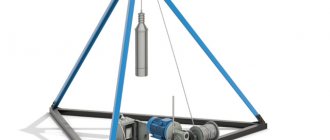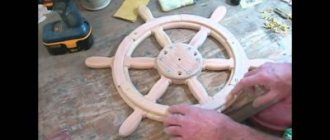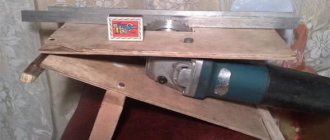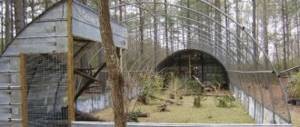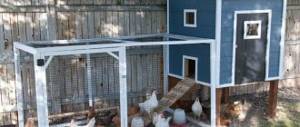I’ll try to tell you how the idea to make pipers—crafts made from pipes—came up. And, in particular, make a balance bike with your own hands.
In 2012, my family and I vacationed in Slovenia. My son turned one and a half years old there - a holiday, sort of. We took him to the Ljubljana Zoo (the capital of Slovenia, for those who don’t know). And at the zoo, on the central alley, some uncles and aunts grabbed children and put them on plywood bicycles without pedals. That's when I saw a balance bike for the first time. But I only found out what this crap is called and what it is for a year later. Because at that moment I was not at all impressed. A few days later I saw a couple of four-year-olds on balance bikes, also called RunBikes. They confidently maintained high speed and looked very natural on balance bikes. And when we approached the cafe, we braked spectacularly: some with their heels, and some with the rear brake, some with a skid. It all looked somehow very deft and easy for such kids. And this picture has already impressed me. And it stuck in my brain: Venya and I approached them, seeming like we were walking, but in fact we were studying the structure (see photo below).
A year later, in a fit of tenderness for my son, I finally ordered a balance bike. Firstbike. Perhaps this time, I was the most patient online buyer in the world: I honestly waited two weeks for the Russian dealer to figure out where and who would place my order. And then the Moscow office didn’t get in touch for another two weeks. But the balance bike arrived, and the dealer paid for the delivery himself - to compensate for his slowness.
I chose a firstbike because of its low weight, the presence of a brake and its resistance to rain and dirt. But what is most important is vandal resistance. Yes, yes, kids - sometimes they are such vandals. While I was waiting for the parcel, my friends were really freaking out about the cost and waiting time. By way of chit-chat, we discussed making things with our own hands. I considered making it only from plywood, because... The first balance bike I saw was a plywood one. It seemed to me that it would be easier to make from plywood. But then, almost simultaneously, messages arrived from two friends: one suggested using polypropylene pipes to build a balance bike, the other sent a link to a project by the Spaniard Bruno Gavira: he made balance bikes from a sewer pipe and wheels from a cargo truck. The project was called “Pipe Bike”.
As far as I know, I think the weight turned out to be around 4...4.5 kg. Mainly because of the wheels. It’s a little heavy, of course, but not critical. In general, a start has been made - I sketched out a sketch, determined the main dimensions of the balance bike and went to look for materials. It took two weeks of intensive searching to find all the materials. The hardest thing was to find the wheels: I found used ones for 500 rubles in a children's store. I haggled for a week and ended up haggling that it was almost taken off sale. I quickly stopped getting confused and took it for full price.
It would seem that polypropylene is not plywood, but there was a lot of garbage.
The impossibility of using serious equipment, technologies and materials gave rise to the concept of making only from things available for sale and from technologies available in everyday life. And this already placed a requirement on the overall thoughtfulness of the design. It is necessary to make a reservation - propylene welds practically do not allow achieving a good presentation. But at the same time, it is an excellent and cheap material for rapid prototyping and single-piece production.
In general, polypropylene is quite difficult to process, and work-related injuries are possible. Although you can foolishly break the hell out of it.
Hence the name for the balance bike: Piper CutFinger. The seat made from an iron corner, of course, turned out to be dangerous. My boy, while riding, hit the edge of the seat with his bare butt. But this is the fate of all test pilots.
In general, the boys liked the running bike. Later it was given to his nephew Ilyusha as a lifelong test of reliability. It just so happened that all the children around me are unwilling testers. Which, however, has not yet been complained about.
PS While I was writing a post and looking for a photo of a Spanish balance bike, I found
I’ll try to tell you how the idea to make pipers—crafts made from pipes—came up. And, in particular, make a balance bike with your own hands.
In 2012, my family and I vacationed in Slovenia. My son turned one and a half years old there - a holiday, sort of. We took him to the Ljubljana Zoo (the capital of Slovenia, for those who don’t know). And at the zoo, on the central alley, some uncles and aunts grabbed children and put them on plywood bicycles without pedals. That's when I saw a balance bike for the first time. But I only found out what this crap is called and what it is for a year later. Because at that moment I was not at all impressed. A few days later I saw a couple of four-year-olds on balance bikes, also called RunBikes. They confidently maintained high speed and looked very natural on balance bikes. And when we approached the cafe, we braked spectacularly: some with their heels, and some with the rear brake, some with a skid. It all looked somehow very deft and easy for such kids. And this picture has already impressed me. And it stuck in my brain: Venya and I approached them, seeming like we were walking, but in fact we were studying the structure (see photo below).
A year later, in a fit of tenderness for my son, I finally ordered a balance bike. Firstbike. Perhaps this time, I was the most patient online buyer in the world: I honestly waited two weeks for the Russian dealer to figure out where and who would place my order. And then the Moscow office didn’t get in touch for another two weeks. But the balance bike arrived, and the dealer paid for the delivery himself - to compensate for his slowness.
I chose a firstbike because of its low weight, the presence of a brake and its resistance to rain and dirt. But what is most important is vandal resistance. Yes, yes, kids - sometimes they are such vandals. While I was waiting for the parcel, my friends were really freaking out about the cost and waiting time. By way of chit-chat, we discussed making things with our own hands. I considered making it only from plywood, because... The first balance bike I saw was a plywood one. It seemed to me that it would be easier to make from plywood. But then, almost simultaneously, messages arrived from two friends: one suggested using polypropylene pipes to build a balance bike, the other sent a link to a project by the Spaniard Bruno Gavira: he made balance bikes from a sewer pipe and wheels from a cargo truck. The project was called “Pipe Bike”.
As far as I know, I think the weight turned out to be around 4...4.5 kg. Mainly because of the wheels. It’s a little heavy, of course, but not critical. In general, a start has been made - I sketched out a sketch, determined the main dimensions of the balance bike and went to look for materials. It took two weeks of intensive searching to find all the materials. The hardest thing was to find the wheels: I found used ones for 500 rubles in a children's store. I haggled for a week and ended up haggling that it was almost taken off sale. I quickly stopped getting confused and took it for full price.
It would seem that polypropylene is not plywood, but there was a lot of garbage.
The impossibility of using serious equipment, technologies and materials gave rise to the concept of making only from things available for sale and from technologies available in everyday life. And this already placed a requirement on the overall thoughtfulness of the design. It is necessary to make a reservation - propylene welds practically do not allow achieving a good presentation. But at the same time, it is an excellent and cheap material for rapid prototyping and single-piece production.
In general, polypropylene is quite difficult to process, and work-related injuries are possible. Although you can foolishly break the hell out of it.
Hence the name for the balance bike: Piper CutFinger. The seat made from an iron corner, of course, turned out to be dangerous. My boy, while riding, hit the edge of the seat with his bare butt. But this is the fate of all test pilots.
In general, the boys liked the running bike. Later it was given to his nephew Ilyusha as a lifelong test of reliability. It just so happened that all the children around me are unwilling testers. Which, however, has not yet been complained about.
PS While I was writing a post and looking for a photo of a Spanish balance bike, I found
I’ve been wanting a balance bike for my little one for a long time, I found a bunch of possible options for implementing and creating my own model for my son, but he’s still small and the work hasn’t started.
I want to share with you what I found and what ideas can be brought to life, here is one of them. I came across it quite by accident on VKontakte, but couldn’t help but write to the author to hear a detailed story about the balance bike.
History of creation:
Vladislav Kondrashov and his son Kostya
“It all started when, once again, wandering through the Internet, I accidentally came across a picture of a cycling race.
I became interested and began to scour the forums in order to find reviews from those who had already bought a similar type of educational vehicle for their child. The key factor was the information that a balance bike, or run bike, as it is also called, is a great way to bypass a 3-wheeled bike and a 2-wheeled bike with extra ones on the sides.
, and at the same time the child learns to maintain balance and does not constantly look at the pedals and get into trouble.
Moreover, before that, we bought a car for our son with a similar principle of movement, and he fell in love with it, but he grew out of it, and he doesn’t want to pedal on a 3-wheeled bike, so we came up with the idea of purchasing a similar type of alternative children’s transport. The creation of the runbike itself began from the beginning based on financial considerations, then the idea grew into the creation of an exclusive runbike. Since the prices for materials on the building materials market are so high that it would be possible to buy a ready-made balance bike, but some of the materials were purchased and therefore it was decided to create a custom bike. Like everything that is done by human hands, I started with simple calculations and a sketch. The first sketch was drawn first, but when I got to the process of cutting plywood and estimating the height of the balance bike and the height of the child, who is the “customer,” it became clear that either the legs reached the floor they won’t get it, or you’ll have to disfigure the balance bike model by cutting off the excess.
So I made a decision and, having little artistic skills, drew sketch No. 2, which was later brought to life.
To create the custom, we purchased: - plywood 150*150cm, 10mm (thickness) - 1 sheet; - 12-inch wheels (pneumatic on spokes) - 2 pcs.; - furniture fittings: - pipe 2.5 m, 25 mm, - connecting corners - 4 pcs, - support flanges - 2 pcs; -metal sheet 50*50cm, 2.5mm (thickness); -bolts, nuts, washers, grommets, screws, rivets; -springs and bearing (for the front fork); -leather (for the seat); - finishing automotive putty NOVOL; -paint: white (instead of primer), beige (ivory), black, red (NUTON aerosol enamel in cans); -and some junk from the garage (small things); - patience and good mood.
its price for me was approximately 2330 RUR. rubles or 75 dollars, for this money you can buy a German or Italian factory balance bike made of metal. My idea was to create an exclusive one for my son, this time and again this design will be equipped with an electric motor, but probably next year, let’s learn how to keep balance first. »
Kostyan is testing his balance bike. On May 28th he will be 3 years old. As Vladislav told me: “at first my son was embarrassed to ride on the street and invited others to ride.”
The guys live in a small village where there is nothing special, so the balance bike attracts the attention of children.
“Children his age try to ride, but they don’t fully understand when they put their feet on the footpegs, the factory ones don’t have footpegs, but I put them on the engine with a long-range view, especially since they don’t interfere with the ride but confuse the children. The older children haven’t tried it, we’re all about the same age, those with whom the little one is friends don’t let others, says my gin-gin
.»
All photos from the article
In this article we are going to get acquainted with the design of a rather unusual vehicle - a balance bike. It is intended for training bikers and cyclists at the very beginning of their “career” - between two and four years. We will find out how a balance bike works, what size it should be and how to make it out of wood with your own hands.
From origins to modern times
Excluding dubious information about frescoes found during excavations with images of structures resembling a bicycle, as well as about the drawings and drawings of Leonardo da Vinci, the German baron Karl von Draize is officially considered the creator of this vehicle. The bicycle he made from ash was devoid of pedals and other mechanisms familiar to us today; it was set in motion by pushing off the ground with our feet, which is why it was called a “running machine”, and in common parlance a trolley. Despite the primitiveness of the design, this wooden bicycle marked the beginning of its further modifications and is the progenitor of all modern bicycles.
Today, the production of structures made from natural materials is rapidly gaining momentum in the sports industry. Many leading manufacturers can boast of interesting conceptual models. One of the most striking representatives of this species is the wooden electric bike. The symbiosis of good old wood and improved mechanisms is increasingly fueling the interest of bicycle modern lovers.
Folk craftsmen are not far behind in their creativity; some of them even manage to recreate a chain mechanism using only wood.
Sometimes funny, sometimes admiring designs delight with their originality, awakening the desire to make a bicycle out of wood with your own hands.
What it is
A bicycle racer (or runbike, from the English runbike) looks like an ordinary children's bicycle, but it completely lacks pedals and any transmission. You can move on it by alternately pushing off the ground with your feet ().
There are only three movable fastenings in this design:
- Front wheel axle;
- Rear wheel axle;
- Steering column.
However: the market offers models with a hand brake. In practice, the child gets along just fine without it: the speeds developed by this vehicle are quite safe and allow you to easily brake with your feet if necessary.
The materials used for the frame are:
- Metal. Metal balance bikes are the most durable, but somewhat heavier than competing solutions;
- Plastic;
- Wood and plywood.
Disputes about the advantages of this or that material on buyer forums do not subside. However, wood has one undoubted advantage: it allows you to assemble a toy for a child yourself.
In fact: even if you have welding and the corresponding skills, a structure welded from a water pipe and a corner will turn out to be excessively massive; well, an extruder for making plastic parts of complex shapes is unlikely to be found in a home workshop.
Why is it necessary to create a balance bike yourself if the modern market offers a variety of models of all shapes, sizes and colors to choose from?
There are two reasons:
- The price of a new balance bike is at least 4,000 rubles. Meanwhile, a limited budget after the birth of a child is the rule rather than the exception for a young family. Making a toy yourself will save you a lot of money;
- In addition, the product can be made completely non-standard. You can, for example, turn it into a custom bike, which will gather all the boys from the surrounding yards on their first trip, or a sportbike, which is no less popular.
Accent on wood
Wooden bikes are distinguished not only by their unique attractive design, but also by their practicality due to the properties of wood:
- material strength;
- elasticity;
- ease of processing;
- vibration absorption, resulting in smooth running.
Manufacturers often use layering technology to create a flexible molded form that creates a solid frame, which adds strength. And they also often combine wood with carbon fiber to ensure the lightness of the product. The finished frame is treated with impregnations against moisture and decay, which ensures the product’s resistance to environmental influences.
The most common tree species used in production: ash, maple, birch, beech, oak, cedar, walnut, sandalwood and other varieties of mahogany. Another material worthy of attention is bamboo. It is, of course, not a tree, but it is not inferior in strength.
DIY wooden bicycle
We are all used to bicycles roaming our streets and know that they are usually made of metal. Despite the affectionate nickname “steel horse,” Japanese master Sueshiro Sano created a wonderful work of art from wood! The idea to replace the usual material with wood came to him when he was working on another pleasure yacht. He, like his father and grandfather, are hereditary shipbuilders. For thirty-two years, Sueshiro Sano built magnificent yachts from mahogany, which surprised with their luxury and grace. In 2008, he first decided to create a bicycle, using a unique material for it - mahogany.
The skill of the specialist is amazing, in addition to the fact that he does everything by hand, all the structures of this work are made of wood, and only the brakes and chain drive are made of metal. At the same time, the weight of the bicycle is quite small and averages seven kilograms and six hundred grams. Such lightness and grace is achieved by the fact that the frame and its steering wheel are hollow. Wood perfectly softens shocks, and the movement of the vehicle becomes smooth, which is very convenient when using a “wooden friend.” Sueshiro Sano founded a mahogany bicycle company and named it Sanomagic. Since the Japanese master makes each creation by hand, the process takes quite a long time, but Mr. Sano is not going to abandon his technology and use mechanization of production. Working on the creation of each of his creations, he puts into these beautiful creations not only the skill of a master, but also his soul. Bicycles attract not only their exclusivity, but also their high durability. After all, their production uses technologies and materials from such an important industry as shipbuilding. Specially treated wood is then coated with high-strength yacht varnish, which is resistant to cold winds, scorching sun rays and heavy rains. Unusual resistance to adverse weather conditions makes the original products even more attractive. From 2008 to 2014, Sueshiro Sano made only eleven wooden bicycles, but in our age of technology and modern materials this is the main value. Every detail of any of these creatures felt the warmth of a living human hand, which was warmed by a loving heart. The works of art that came out of Mr. Sano's workshop will serve people and bring them joy for many years to come.
Short link: https://ex3m.com.ua/mtfRi
ex3m.com.ua
How to make a bicycle out of wood
Some manufacturers offer the buyer a kind of “do-it-yourself” construction kit - that is, such a kit contains all the parts of the bicycle, as a result of which, as a result of fastening, a full-fledged vehicle is obtained. You can also find instructions for assembling branded bicycles posted on the websites by the developers themselves (not for free) and make a similar bike yourself. But if your craving for modernization is coupled with the desire to own an exclusive model, then you should still make a bicycle out of wood with your own hands.
Interesting things made from plywood
Sandwichbike - a sandwich bike made of plywood
A wooden bicycle can claim to be a work of art, like the Woody Scorcher, which was recently featured on Facepla.net. Or it can be unpretentious and simple, like... a bicycle. Sandwichbike, the brainchild of designers from Holland, features a flat plywood frame. The home assembly kit is available to order today.
The path from a concept presented to the public by the design agency Bleijh in 2006 to an industrial product took seven long years. At one time, the studio only created the idea of a green vehicle made from renewable materials. However, the unexpected success encouraged the designers to undertake commercial development. In 2011, Pedalfactory was created to bring Sandwichbike to market.
If you look at the design, it is immediately clear what was the reason for choosing the name “sandwich bicycle”. The frame of a simple single-speed bicycle is made of plywood and consists of two flat parts. Several aluminum cylinders connect the halves together and serve as attachment points for all other parts. It turns out that the entire bike is sandwiched between flat frame segments, like the filling of a sandwich between two pieces of bread.
The buyer will receive a flat cardboard box containing the entire DIY kit, consisting of less than 50 parts. According to preliminary data, the weight of the parcel will be about 13 kg.
According to designer and engineer Ite Kingma, the team chose wood as the most suitable and friendly material. However, Kingma does not consider the Sandwichbike to be an ordinary wooden bicycle and clarifies that an important component of their idea is the work of assembling it yourself and gaining new knowledge. Evaluating the time spent developing and bringing a commercial version of the concept to market, Ite Kungma put it this way: “If you want to do something, you must do it with complete confidence and with complete quality,”
By purchasing a box with a set of parts neatly laid out and completely ready for assembly, the company’s client gets the opportunity to expand his horizons, understand the mechanics and anatomy of a green vehicle. After a short and exciting assembly process, the buyer becomes the owner of a reliable and unpretentious, neat and durable, environmentally friendly product.
The company is accepting pre-orders for Sandwichbike now. The cost of bicycle kits from the first batch is 799 euros.
Based on internet materials...
Design elements
How and what exactly is the easiest way to assemble ours?
Wheels
In this capacity you can use:
- Wheels from a broken or unnecessary children's bicycle;
- Wheels for garden cart with a diameter of 10 - 12 inches.
The presence of rolling bearings is welcome: they will reduce rolling resistance and reduce wear on the wheel hub. Whether it is pneumatic or foam rubber under the tire does not matter: the loads on the wheels are so small that the difference in the quality of shock absorption does not play a special role.
A pin or bolt threaded through the frame elements is used as an axis. The frame is secured on the inside with a nut and washer.
Frame
The most practical material for the frame is FC plywood with a thickness of 12-15 millimeters. The frame is double, with a gap between the sidewalls corresponding to the width of the wheel, taking into account the nuts securing the axle.
Seat
The non-adjustable saddle is attached to the double frame with a pair of furniture corners. It is advisable to cover it with leather or leatherette with a foam rubber lining; the covering is fastened with a furniture stapler or glued from the back.
The instructions for creating an adjustable saddle are not much more complicated: the stand is assembled from a couple of layers of thick plywood with glue; the seat is again attached to the counter with furniture corners. Then a series of holes are drilled in the post and frame with the same distance between them. To fix and rearrange the saddle, screws with semi-countersunk heads are used.
Steering wheel
The steering column rotary assembly can be implemented in different ways.
Here are the two simplest:
- A shovel handle is used as a stand. It is oiled to reduce friction and fixed to the frame cross member with two steel clamps; in this case, the plywood is again secured with nuts on both sides;
- Instead of a cutting, you can use a piece of smooth reinforcement. In this case, both the clamps and the lining fixing the rod are made of thick plywood.


